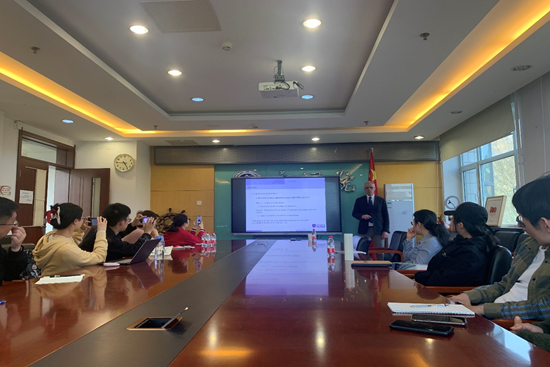On April 9, the Business School of Beijing Technology and Business University successfully held the 1st Logistics and Supply Chain Management Frontier Forum of 2024. The forum invited Professor Francisco Saldanha da Gama, a renowned scholar from the Management School of the University of Sheffield in the UK, to deliver an academic report titled "The latency location-routing problem with stochastic travel times" for the faculty and students. The forum focused on the latest research results and cutting-edge trends in the field of logistics and supply chain management. The forum was chaired by Professor Cui Li, the head of the Digital Operations Department of the Business School, along with Deputy Directors Zhu Yuting, Yan Kewen, and other core teachers, doctoral and master's students, as well as some teachers and students from outside the school.

Professor Cui Li extended a warm welcome to Professor Francisco Saldanha da Gama and pointed out the significance of the forum in enhancing the academic level of the college in the field of logistics and supply chain management. Subsequently, Professor Francisco Saldanha da Gama provided a comprehensive and in-depth analysis of the facility location problem with his profound professional quality and unique insights. He began with the research background, elaborating on the importance and complexity of the facility location problem in today's society. With the rapid development of globalization and urbanization, facility location is no longer a simple issue of geographical location selection but involves a comprehensive consideration of economic, social, and environmental factors. He then emphasized the key role of model setting in problem-solving and proposed several common methods for model setting. These methods include considering factors such as geographical location, traffic conditions, population distribution, and how to quantify these factors and incorporate them into the model for calculation. Through specific case analysis and comparison, he demonstrated the impact of different model settings on the final results, giving participants a deeper understanding of the issue. In addition, he pointed out that exact algorithms can obtain optimal solutions but have high computational complexity, suitable for problems of small scale or high precision requirements; while heuristic algorithms can obtain approximate optimal solutions in a relatively short time, suitable for large-scale or real-time requirements. By comparing the application examples of different algorithms in the facility location problem, he made the participants more clearly understand the differences and applicable scenarios of these two algorithms in practical applications.
After the forum, the attending teachers and doctoral students engaged in a warm and in-depth exchange and discussion with Professor Francisco Saldanha da Gama. In terms of model construction, everyone expressed their views and suggestions on how to better incorporate practical factors into the model and how to improve the accuracy and practicality of the model. Professor Francisco Saldanha da Gama patiently answered everyone's questions and shared his experience and insights in model construction. In terms of paper submission and writing, Professor Francisco Saldanha da Gama offered valuable advice. He emphasized the novelty of the paper topic, the innovation of the research method, and the rigor of data analysis, all of which are key factors affecting the quality of the paper. At the same time, he also shared some of his experiences and skills in the process of paper writing and submission, including how to choose the right journal, how to write an engaging abstract and conclusion, etc. In addition, choosing the right journal is crucial for the publication and academic influence of the paper. Therefore, it is necessary to fully understand the journal's positioning, review cycle, and publication difficulty before submission in order to be able to submit one's research results to the most suitable journal.

This forum provided a platform for participants to exchange academic ideas and share research results, and also allowed everyone to deeply feel the charm and value of academic research. At the same time, it demonstrated the academic strength of the Business School in the field of logistics and supply chain management, providing a platform for academic exchange in line with international standards for teachers and students, which helps to promote the continuous development of the college in this field. In the future, the Business School will continue to hold more similar academic activities to create more learning and exchange opportunities for teachers and students.
